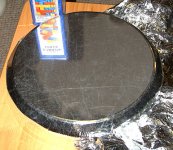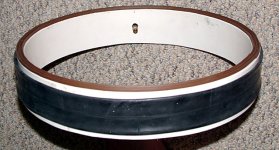Don't neglect the optical properties of metallized films!
Check out:
http://www.de.afrl.af.mil/factsheets/L-Mirror.html
http://www.niac.usra.edu/files/library/meetings/annual/jun00/416Palisoc.pdf
http://www.okotech.com/publications/sid.pdf
http://www.hitl.washington.edu/research/true3d/mirrors.html
http://caao.as.arizona.edu/publications/publications/OSA_Tucson_Final.pdf
http://homepages.strath.ac.uk/~clcs09/papers/ber/petber2.htm
http://vis4d.ncms.org/3639a-15.pdf
http://oemagazine.com/fromTheMagazine/oct01/stretchingthelimits.html
Google for "membrane mirror", "stretched film mirror", and any similar phrases involving membrane, film, mirror, etc.
As soon as final exams are over I will be making a trial size mirror (12" diameter). I want to get up to about 1m diameter if things look OK at 12".
Gratuitous audio content:
One could use an audio transformer to modulate the focal length of a metallized film mirror if you put a metal screen behind the film. Simply connect the HV side of the transformer to the film and the screen. As amplitude of signal applied increases, focal length of mirror becomes shorter. Should have wide frequency response...
I_F
Check out:
http://www.de.afrl.af.mil/factsheets/L-Mirror.html
http://www.niac.usra.edu/files/library/meetings/annual/jun00/416Palisoc.pdf
http://www.okotech.com/publications/sid.pdf
http://www.hitl.washington.edu/research/true3d/mirrors.html
http://caao.as.arizona.edu/publications/publications/OSA_Tucson_Final.pdf
http://homepages.strath.ac.uk/~clcs09/papers/ber/petber2.htm
http://vis4d.ncms.org/3639a-15.pdf
http://oemagazine.com/fromTheMagazine/oct01/stretchingthelimits.html
Google for "membrane mirror", "stretched film mirror", and any similar phrases involving membrane, film, mirror, etc.
As soon as final exams are over I will be making a trial size mirror (12" diameter). I want to get up to about 1m diameter if things look OK at 12".
Gratuitous audio content:
One could use an audio transformer to modulate the focal length of a metallized film mirror if you put a metal screen behind the film. Simply connect the HV side of the transformer to the film and the screen. As amplitude of signal applied increases, focal length of mirror becomes shorter. Should have wide frequency response...
I_F
Hmmm... Optics...
Wow, there might be applications in real optics fields...
Like voltage controlled focus/reflection units for telescopes or something..
Or, a lens/reflector that would be responsive to the amount of electrostatic charge in the environment if it was large enough.
There's got to be an application where you could use that.
Speaking of using that, I could use some 4-10 micron aluminized/sputtered mylar film.
Wow, there might be applications in real optics fields...
Like voltage controlled focus/reflection units for telescopes or something..
Or, a lens/reflector that would be responsive to the amount of electrostatic charge in the environment if it was large enough.
There's got to be an application where you could use that.
Speaking of using that, I could use some 4-10 micron aluminized/sputtered mylar film.
On earth you can use a pressure differential between the atmosphere and a chamber enclosing the back side of the mirror to achieve a convex or concave shape. The curve will be approximately spherical (pressure acts on the film normal to its surface). For optical use there are a number of problems- it's no slam-dunk.
The film is a polymer. That means it has long molecules, that due to manufacturing processes, tend to line up parallel to each other. When the metal is deposited on the film, it sticks to the molecules which are lined up, so it forms little "wires" oriented along the length of the molecules. This all contributes to a couple problems. First, the spring constant of the film will not be isotropic. The molecules will tend to stretch more in one direction than the other. Second, reflections off the mirror will tend to be polarized because of the "wires". There may also be some diffraction from this.
Then there are the other problems:
1) gravity- if the mirror is tilted, the weight of the film will distort the shape of the mirror.
2) sound- the low mass of the diaphragm means it will vibrate with every sound, breeze, etc.
3) curvature- a mirror for telescope use, for example, is ideally parabolic, not spherical. There will be problems with the image.
4) the shape of the frame- if it isn't perfectly circular, you won't have a spherical mirror but some other shape.
5) the edge of the frame- if it isn't flat and smooth, the mirror's curve will be distorted by the uneven/unround surface of the edge.
6) sensitivity to barometric pressure/temperature variations- the mirror's curve is determined by the pressure differential between the closed chamber behind the mirror and the atmospheric pressure. If the temperature changes a bit, the pressure in the closed chamber will change, causing the curve of the mirror to change.
There are other problems- variation in the thickness of the film, density of the metal coating, etc. etc.
That said, there are plenty of applications where some of these "problems" can be turned into advantages. For example, the sensitivity to emperature and pressure variations- one could seal the rear chamber and use the focal length of the mirror as an indicator of temperature/pressure.
A 1m diameter mirror would make a hell of a solar collector for roasting weenies or melting plastic soldiers... Errors in shape, vibrations, etc., won't matter at all.
Some of the links I posted have some very interesting display systems where the exact curvature of the mirror and small vibrations are not a problem. I'm sure there are many others waiting to be discovered.
I_F
The film is a polymer. That means it has long molecules, that due to manufacturing processes, tend to line up parallel to each other. When the metal is deposited on the film, it sticks to the molecules which are lined up, so it forms little "wires" oriented along the length of the molecules. This all contributes to a couple problems. First, the spring constant of the film will not be isotropic. The molecules will tend to stretch more in one direction than the other. Second, reflections off the mirror will tend to be polarized because of the "wires". There may also be some diffraction from this.
Then there are the other problems:
1) gravity- if the mirror is tilted, the weight of the film will distort the shape of the mirror.
2) sound- the low mass of the diaphragm means it will vibrate with every sound, breeze, etc.
3) curvature- a mirror for telescope use, for example, is ideally parabolic, not spherical. There will be problems with the image.
4) the shape of the frame- if it isn't perfectly circular, you won't have a spherical mirror but some other shape.
5) the edge of the frame- if it isn't flat and smooth, the mirror's curve will be distorted by the uneven/unround surface of the edge.
6) sensitivity to barometric pressure/temperature variations- the mirror's curve is determined by the pressure differential between the closed chamber behind the mirror and the atmospheric pressure. If the temperature changes a bit, the pressure in the closed chamber will change, causing the curve of the mirror to change.
There are other problems- variation in the thickness of the film, density of the metal coating, etc. etc.
That said, there are plenty of applications where some of these "problems" can be turned into advantages. For example, the sensitivity to emperature and pressure variations- one could seal the rear chamber and use the focal length of the mirror as an indicator of temperature/pressure.
A 1m diameter mirror would make a hell of a solar collector for roasting weenies or melting plastic soldiers... Errors in shape, vibrations, etc., won't matter at all.
Some of the links I posted have some very interesting display systems where the exact curvature of the mirror and small vibrations are not a problem. I'm sure there are many others waiting to be discovered.
I_F
First attempt
I made a 12" diameter round stretcher from a piece of PVC pipe. I cut the ends as close to square as I could (very close, actually), drilled a hole for a bicycle tire tube valve, stretched a 12" tire tube over the pipe, and attached some double-stick tape to the inside edge of the pipe. I also added some foam weather strip tape to the edge of the pipe.
Next I laid some film out on a flat surface, put the stretcher down on it, weather strip side down, and wrapped the film over the frame and stuck it to the double-stick tape all the way around the frame. I connected an air pump and gave it a little air and Voila! A perfectly stretched mirror!
The plan is to transfer the film from this stretcher to another piece of pipe that has a lathe cut square edge- I will put contact cement on the pipe and on the film and put the two together. Then cut the film free of the stretcher.
Thanks to Moray James for the film samples!
Here's a picture...
I_F
I made a 12" diameter round stretcher from a piece of PVC pipe. I cut the ends as close to square as I could (very close, actually), drilled a hole for a bicycle tire tube valve, stretched a 12" tire tube over the pipe, and attached some double-stick tape to the inside edge of the pipe. I also added some foam weather strip tape to the edge of the pipe.
Next I laid some film out on a flat surface, put the stretcher down on it, weather strip side down, and wrapped the film over the frame and stuck it to the double-stick tape all the way around the frame. I connected an air pump and gave it a little air and Voila! A perfectly stretched mirror!
The plan is to transfer the film from this stretcher to another piece of pipe that has a lathe cut square edge- I will put contact cement on the pipe and on the film and put the two together. Then cut the film free of the stretcher.
Thanks to Moray James for the film samples!
Here's a picture...
I_F
Attachments
- Status
- This old topic is closed. If you want to reopen this topic, contact a moderator using the "Report Post" button.

